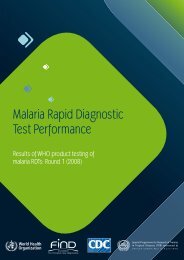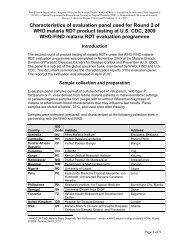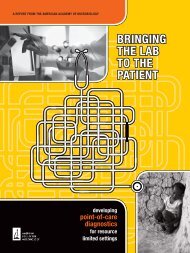MGIT TM Procedure Manual - Foundation for Innovative New ...
MGIT TM Procedure Manual - Foundation for Innovative New ...
MGIT TM Procedure Manual - Foundation for Innovative New ...
Create successful ePaper yourself
Turn your PDF publications into a flip-book with our unique Google optimized e-Paper software.
Section II: <strong>Procedure</strong> <strong>for</strong> Primary Isolation<br />
Note: In some instances, especially if mycobacterial growth is extremely slow or there is<br />
less oxygen consumption during mycobacterial growth, there may be growth in the <strong>MGIT</strong><br />
broth without the presence of fluorescence. It is recommended that at the termination of<br />
incubation protocol, all negative tubes should be observed visually <strong>for</strong> turbidity and growth<br />
be<strong>for</strong>e discarding. If there is any suspicion of growth, an AFB smear and subculture should<br />
be done. This eliminates chances of reporting false negatives. If <strong>MGIT</strong> results are not<br />
satisfactory due to poor recovery, delay in detection or high contamination rate, follow the<br />
instructions <strong>for</strong> troubleshooting (Appendix C). Quality Control <strong>for</strong> the reagents and products<br />
used in the isolation, as well as <strong>for</strong> the test procedure, is critically important <strong>for</strong><br />
mycobacteriology laboratories (see Section II-K, Quality Control).<br />
G. Work-up of Positive Cultures<br />
1. AFB smear from a positive <strong>MGIT</strong> tube<br />
Once a <strong>MGIT</strong> tube is positive by fluorescence or by visual observation, prepare a smear and<br />
stain with carbol fuchsin stain.<br />
<strong>Procedure</strong><br />
• Use a clean slide.<br />
• Mix the broth by vortexing and then by using a sterile pipette, remove and aliquot.<br />
Place 1-2 drops on the slide and spread over a small area (approx. 1½ x 1 cm).<br />
• Let the smear air dry.<br />
• Heat-fix the smear by passing it over a flame a few times or by using an electric<br />
warmer at 65ºC -70ºC <strong>for</strong> 2 hours to overnight. Do not leave the smear openly<br />
exposed to the UV light of the safety cabinet.<br />
• Stain the smear with Ziehl-Neelsen, Kinyoun’s or BBL® Quick Stain. Fluorochrome<br />
stain is NOT recommended. Air dry but do not blot dry.<br />
• Place a drop of oil on the stained and completely dried smear and screen under a low<br />
power objective to locate stained bacteria. Switch to an oil immersion objective lens<br />
<strong>for</strong> detailed observation.<br />
• If the broth appears turbid or contaminated, irrespective of AFB smear results,<br />
subculture on a blood or chocolate agar, or TSI, to rule out the presence of<br />
contaminating bacteria.<br />
• If the smear is negative <strong>for</strong> AFB and the tube does not appear to be contaminated, i.e.<br />
broth is clear, re-enter the tube into the instrument <strong>for</strong> further monitoring. Repeat<br />
AFB smears after 1-3 days.<br />
<strong>MGIT</strong> <strong>TM</strong> <strong>Procedure</strong> <strong>Manual</strong> 29




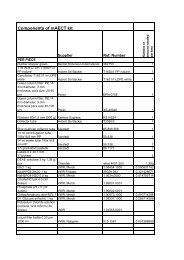
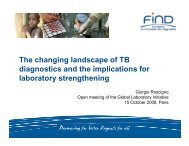
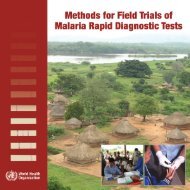
![Download in English [pdf 2Mb] - Foundation for Innovative New ...](https://img.yumpu.com/49580359/1/184x260/download-in-english-pdf-2mb-foundation-for-innovative-new-.jpg?quality=85)

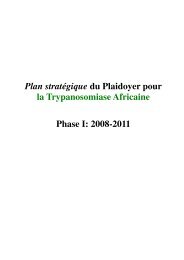
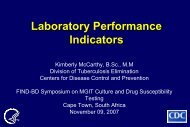
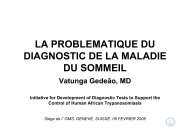
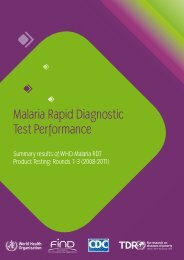
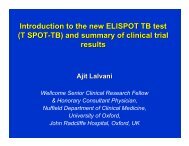
![New laboratory diagnostic tools for tuberculosis control [.pdf]](https://img.yumpu.com/43339906/1/190x135/new-laboratory-diagnostic-tools-for-tuberculosis-control-pdf.jpg?quality=85)
